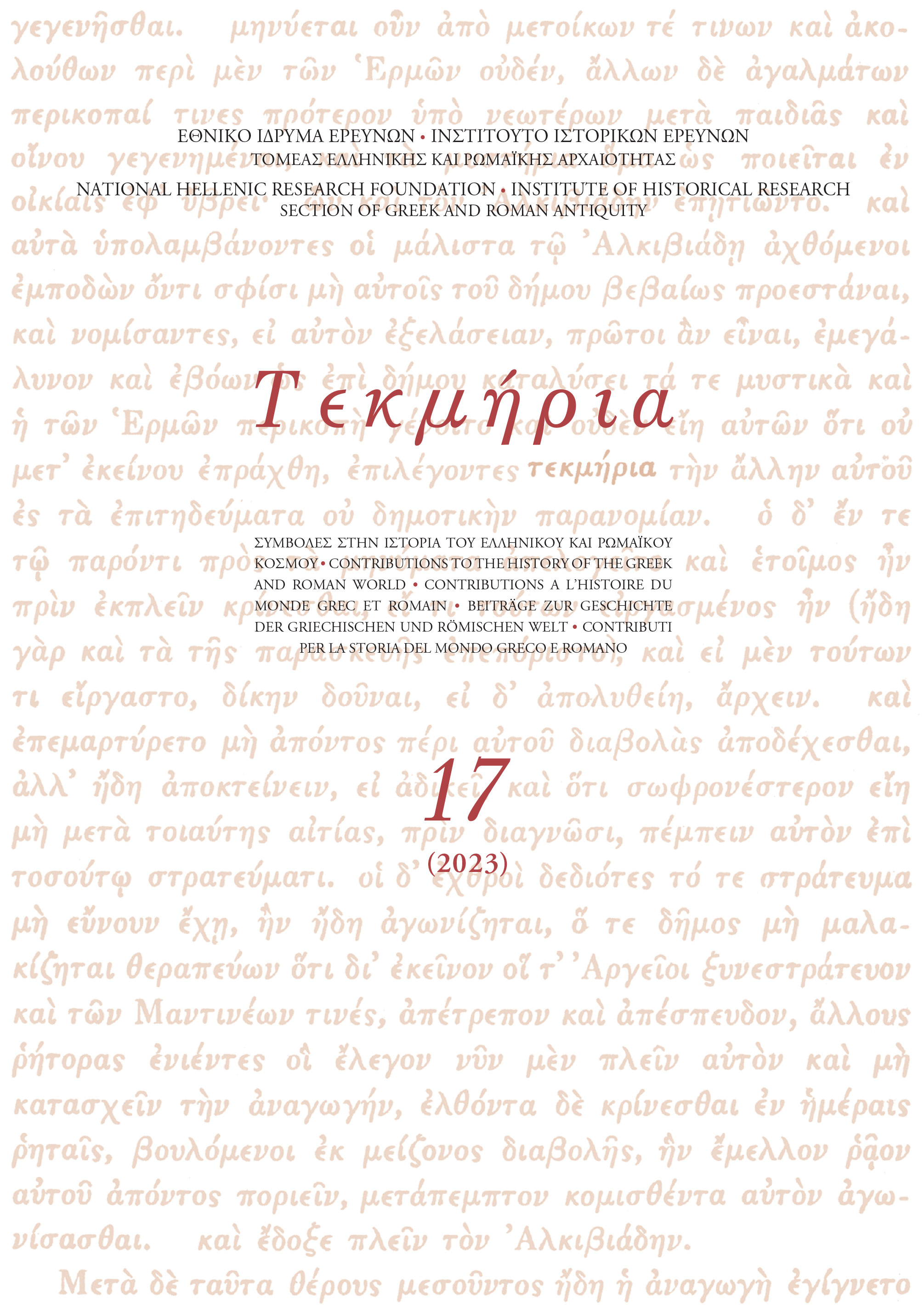New Names, Status and Family Sentiment in Multi-ethnic Cappadocia: Greek Inscriptions from the Museum of Malatya

Abstract
This article offers an edition of 19 Greek inscriptions from the Museum of Malatya (ancient Melitene, Cappadocia), among them 13 previously-unpublished texts including two new metrical inscriptions. With the exception of the one in the Appendix, these texts are funerary, should be dated to the period c. 150-250/300 AD, and take the form of family members dedicating funerary monuments in commemoration of deceased relatives. They offer significant insight into naming habits in this part of inland Asia Minor at the time of the Roman empire, not least in the use of Greek and Roman conventions including double-names and short names; among the inscriptions are several names otherwise not firmly attested in otherwise-published inscriptions (Amate, Anophthenes, Atios, Mazoubine, Taurophilos). A plague or illness is attested in one inscription. The funerary formulae of these inscriptions offer insight into the use of traditional Greek acclamations and also the translation into Greek of the Latin habit of dedicating funerary monuments to the Household Gods. The physical aspects of the stelai, featuring pedimental decorations, acroteria and inscribed texts, and sometimes objets de toilette, echo Greek traditions in commemoration but also constitute a recognisably local style. Aspects of the human bust portraits on a number of the monuments resemble those known elsewhere in inland Asia Minor. The metrical aspect of two of the inscriptions demonstrates a further level of artistry and engagement with a long Greek epitaphic tradition and indicates an aspirational literary ostentation. Overall, they illustrate the mingling of Greek, Roman and other cultures in a region influenced by the presence of the 12th Roman Legion; in particular they enunciate the signi cance of funerary display across the cultural spectrum and demonstrate the power of private funerary monuments to express family ties in Cappadocia at a time of Roman power.
Summary for Turkish Readers
Türkçe Özet:
Birden Çok Etnik Unsur Barındıran Antik Kappadokia Bölgesinde Yeni İsimler, Mevkiler ve Ailevi Duyarlılık: Malatya Müzesi’nden Antik Yunanca Yazıtlar
Malatya Arkeoloji Müzesi’ndeki Antik Yunanca yazıtlar, ilgili Müze Müdürlüğü’nün 3 Haziran 2021 tarih ve E-28262782-806.01.03-1429753 sayılı izinleri ile çalışılmış ve bu makale kapsamında yayınlanmıştır. Müze’deki gerekli belgeleme işlemi Dokuz Eylül Üniversitesi’nden Arkeolog Alev Çetingöz tarafından Ağustos 2021 tarihinde gerçekleştirilmiştir.
Bu makalede toplam 18 adet Yunanca yazıtlı taş eser takdim edilmektedir. Makalede önce, Müze’de teşhirde olan ve daha önce yayını yapılmış Antik Yu- nanca yazıtlı beş adet mezar steli tanıtıldıktan sonra, daha önce yayını yapılmayan 13 adet yazıt tanıtılmıştır. Yazıtların 17 adeti İ.S. 2.-3. yy. arasına, yani Roma Dönemi’ne, biri ise İ.S. 5.-6. yy.’a aittir.
Makalede tanıtılan eserlerin içeriği sırası ile şöyledir: a. Daha önce yayınları yapılmış yazıtlar: i- Helene tarafından kocası için yaptırılan mezartaşı, ii- Anneleri Na için oğullarının yaptırttıkları mezartaşı, iii- Kyrilla tarafından annesi Priska için yaptırılan mezar yazıtı fragmanı, iv- Proklos tarafından Mikke için yaptırılan mezartaşı, v- Protogenes tarafından karısı Euphratia için yaptırılan mezartaşı ile vi- Mazoubine tarafından kocası Antonius Valens ve annesi Ma için yaptırılan mezartaşı.
b. Daha önce yayınlanmamış yazıtlar: 1- Aribas tarafından babası ve kız kardeşi Kyrille için yaptırılan mezartaşı, 2- Loukios tarafından karısı Gemella için yaptırılan mezartaşı, 3- Yeraltı tanrılarına adanan mezartaşı, 4- Aouillios (Avillius) tarafından kızkardeşi Amate için yaptırılan mezartaşı, 5- Klaudios Amiantos tarafından karısı Iphigeneia ve kendisi için yaptırılan mezartaşı, 6- Antipas tarafından kız kardeşi Glaphyra için yaptırılan şiir vezinli mezartaşı, 7- Taurophilos tarafından karısı Ame (Nea) için yaptırılan mezartaşı, 8- Kyrillos tarafından annesi Alia Stratoneike için yaptırılan şiir vezinli mezartaşı, 9- Roustikos ve Iasonis tarafından oğulları Roustikos için yaptırılan mezartaşı, 10- Axios tarafından karısı için yaptırılan mezartaşı, 11- Apollonios ve Athenion tarafından Nikias için yaptırılan mezartaşı ile 12- Anakon ve Proklos adları geçen yazıt.
Makalenin sonunda ise üzerinde Hristiyan azizi Theodoros’un adının geçtiği Erken Bizans Dönemi’ne ait bir taş eser tanıtılmaktadır.
Article Details
- How to Cite
-
Laflı, E., Liddel, P., Çetingöz A., & Mitford, T. B. (2023). New Names, Status and Family Sentiment in Multi-ethnic Cappadocia: Greek Inscriptions from the Museum of Malatya. Tekmeria, 17, 173–231. https://doi.org/10.12681/tekmeria.34979
- Issue
- Vol. 17 (2023)
- Section
- Articles

This work is licensed under a Creative Commons Attribution-NonCommercial-ShareAlike 4.0 International License.
Copyright
The copyright for articles in this journal is retained by the author(s), with first publication rights granted to the journal. Authors who submit articles to this journal confirm that third-party intellectual property rights are not violated in any way. By virtue of their appearance in this open access journal, articles can be used freely, with proper attribution, for educational and other non-commercial purposes. The National Hellenic Research Foundation retains the right to publish papers that appear in ΤΕΚΜΗΡΙΑ in any form, including electronic, the journal may assume in the future. It also retains the right to deposit articles published in ΤΕΚΜΗΡΙΑ in its institutional repository.
Sample attribution: Author, article title, first published in ΤΕΚΜΗΡΙΑ, Vol. No., Year, Pages.


